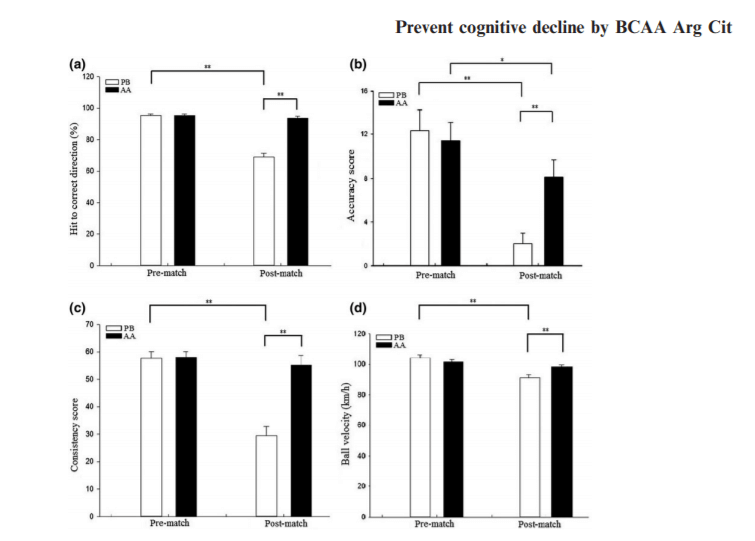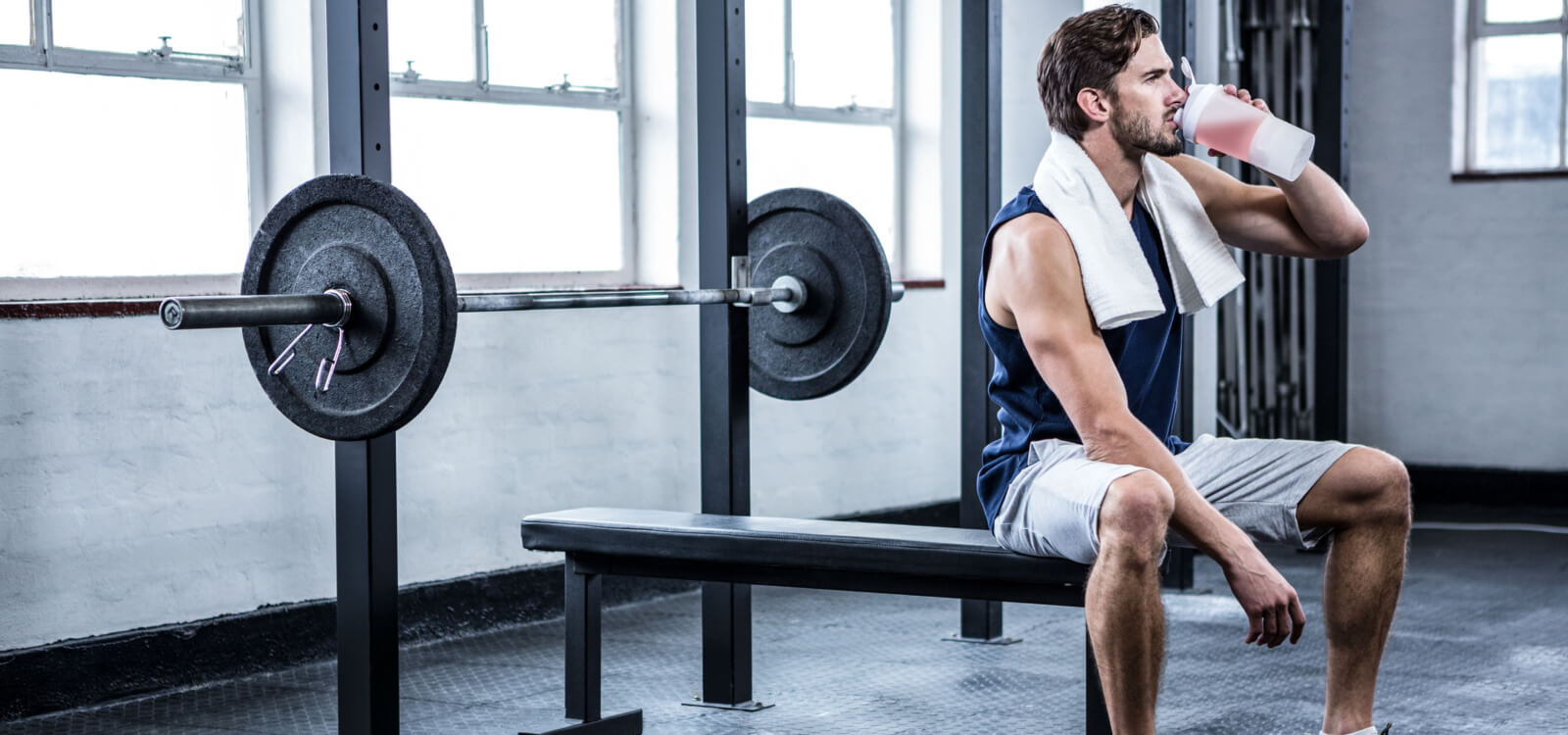Key Takeaways
- L-citrulline malate has consistently shown moderate yet reliable benefits, while branched chain amino acids (BCAAs) have long since been theorized to reduce fatigue with somewhat lacklustre results.
- It turns out L-citrulline may work synergistically with BCAAs to help reduce fatigue more than BCAAs or L-citrulline alone.
- The combination of BCAAs and L-citrulline malate may be synergistic enough to influence the performance of elite athletes to a surprisingly large degree … under certain conditions.
Branched Chain Amino Acids (BCAAs) have a weird history as an ergogenic.
In recent years it’s become widely known that they aren’t really the best for building muscle or, at the very least, there are other simpler or cheaper options out there—leucine and protein powder specifically.
The niche of branched chain amino acid supplements has dwindled since then.
Perhaps, however, we were mistaken.
Maybe we got sidetracked with the whole “leucine is all you need to stimulate muscle growth” part and fallaciously assumed that BCAAs were just bad at building muscle … which they kind of are … but fish suck at climbing trees and all that.
Perhaps the benefit of BCAAs is not specifically related to leucine but more related to …
Drumroll …
The fact they have branched chains.
Yup, it’s right there in the damn name.
There has been a longstanding theory of BCAAs reducing what we call “central fatigue,” a type of fatigue that arises in the brain due to neurotransmitter balance rather than the fatigue your muscles get when byproducts of exercise (such as lactic acid) impair exercise.
The theory, with data going back to at least 1987, suggests that tryptophan rises in the brain during exercise and when there is more tryptophan there it promotes the production of serotonin (which is known to convert into melatonin)—this process seems to be related to fatigue.
Tryptophan is a large, neutrally charged, amino acid. So are BCAAs, and BCAAs are kind of dickwads and can physically block tryptophan from getting into the brain.
So why haven’t we used BCAAs more frequently?
Well, it turns out that introducing high levels of amino acids in general can promote ammonia production—ammonia, a byproduct of amino acid metabolism, can independently promote fatigue.
Enter, L-citrulline malate.
L-citrulline malate is independently a great pre-workout supplement that can help promote endurance. This is commonly attributed to blood flow but also related to “recycling” waste products such as lactate and ammonia from the body.
Could the inclusion of L-citrulline alongside BCAAs help the latter out to become a better supplement? Could L-citrulline be the crutch that BCAAs need to excel?
Those will be the studies (yes, 2 studies) I’ll be covering today. Testing whether or not this synergism can take a once failed supplement and put it into such intense situations where most supplements fail.
The results may shock you. At least one of them shocked me.
What Did The Researchers Do?

We’ll be covering 2 related studies on L-citrulline malate for a reason.
There are some important similarities between both trials, the first being that they came from scientists at the University of Taipei, Taiwan.
The first is a study in taekwondo athletes conducted by Chen et al. at the Graduate Institute of Sport Coaching Science and the latter a tennis trial by Yang et al. both conducted at the Graduate Institute of Sports Training (both departments of the same university).
Similarities Between Trials
The primary similarity between these trials is that they are both comparing the same amino acid solution against placebo. The supplement in question is as follows:
- L-citrulline (malate not specified) at 0.05 g/kg
- L-arginine at 0.05 g/kg
- BCAAs at 0.17 g/kg (a combination of leucine, isoleucine, and valine)
The above may be easier to comprehend when we think about what it means for a 150 lb (68 kg) individual. They would consume:
- 3.4 grams L-citrulline
- 3.4 grams L-arginine
- 11.5 grams of BCAAs providing 5.8 grams leucine
So the doses are in line with what we could call “clinically effective doses” based on previous research. On the higher end when it comes to most dietary supplements but not obscenely impractical.
L-citrulline malate is primarily used for its ability to reduce ammonia and lactate during exercise (secondary to increasing nitric oxide.) It appears L-arginine was included on a similar premise although it was not specified why the researchers chose to include both.
BCAAs are thought to reduce fatigue secondary to the role of the BCAAs in antagonizing tryptophan—they share the same transporter into the brain so it’s thought that, by disallowing tryptophan to enter the brain, sedation and fatigue is reduced by presence of BCAAs.
The following studies are designed to test central fatigue, but previous research suggested that ammonia buildup (from the amino acids) could impair the benefits of BCAAs inherently. As such, L-citrulline and L-arginine were added to help counter this.
And now for the surprisingly interesting trials this supplement was tested in …
Recommended Reading:
BCAAs, Citrulline, and Taekwondo
The taekwondo trial assessed this amino acid solution in a double blind manner over the course of 3 simulated matches.
Specifically, 12 highly trained young adults (minimum 6 years experience and have at least once competed at the national or international level) were given this solution or placebo after the first 2 simulated matches but before the final one.
Both the test group and the placebo group had controlled breakfasts and for the 2 days leading up to the trial as to eliminate diet as a confounding factor as much as possible.
This was then repeated on another day but with the groups reversed; a double blind crossover study. This is usually used to get better data from groups that, by their design, can’t have that large of a sample size (hey, you try getting a sample of 200 elite taekwondo players.)
Athletes were specifically assessed for what is called premotor reaction time assessed by this battery of tests—lots of taekwondo-specific kicks.
Physical reaction time can be broken down into premotor reaction time (PRT) and motor reaction time (MRT) where the former is how fast the body can prime itself to take action. It refers to the time between the stimuli being presented and the motor neurons being told to recruit.
The theory is that the supplementation would preserve endurance and performance.
Keep in mind this is a highly sport-specific task, the participants were all elite athletes, and they were fatigued from performing in their sport directly with competitors of their own skill level.
BCAAs, Citrulline, and Tennis
The tennis trial took the same supplement and went the other way with it.
If the previous trial was able to demonstrate that the solution is able to preserve physical endurance and performance, what about cognitive?
Could things such as hand-eye coordination be preserved the same as motor coordination?
This study got 9 male tennis players, all of which had at least 8 years experience and have at least once participated at the national level. They were also treated similarly to the other study in regards to diet (being controlled between groups 2 days prior to testing.)
This test was also a crossover study due to the low sample size and, for some reason, only single blind. Weird.
Participants were subject to a “simulated match” in which they faced off against the Skynet tennis overlord, a ball shooting machine, for 12 receiving and 12 serving games with minimal rest in between.
The intensity was designed to be comparable to an actual match between national level athletes (assessed by heart rate, rate of perceived exertion, and duration.)
Afterwards, the athletes were tested via a “groundstroke test” (modified from this study) where players returned 60 balls at a rate of 15 balls per minute each of which are fired at 100 km/h. Then they did it again, cause if you get full rights to torture athletes why not enjoy it to the fullest?
(Well, specifically for you tennis enthusiasts, the first 60 balls were switching between forehand and backhand returns while the next 60 balls were switching which side of the court the ball was returned towards.)
So to recap—we have two studies using national level athletes given this amino acid solution, primarily L-citrulline malate and BCAAs. They were both tested under conditions that are highly reflective of their actual sports rather than putting them on exercise bikes and extrapolating the data.
So, how did supplementation fare?
Recommended Reading:
What Were The Study Results?

The study results hinge on how supplementation affected the unique sport-specific tests.
BCAAs, Citrulline, and Taekwondo Results
The taekwondo-specific tests showed that, before supplementation was introduced, both groups performed at a statistically similar level.
After supplementation was introduced, the supplement group had an increase in premotor reaction time compared to placebo. Put in other words, they reacted to the stimuli faster and their motor neurons were able to initiate the movement faster.
However, actual motor reaction time and the speed of the kicks appeared to remain unchanged relative to placebo.
Furthermore, the rate of perceived exertion (RPE) and and overall power output in matches were not significantly different.
This can be interpreted as the amino acid cocktail being able to keep somebody, cognitively, “on their game” and reacting to stimuli well but can also be interpreted as a failure to prevent fatigue-induced weakness or slowing of the muscles.
For people who want a supplement to help prevent central-fatigue during high intensity sports this is a great result—preservation of physical power during sports? Not so much.
BCAAs, Citrulline, and Tennis Results
The tennis results were effectively gauged by how much, and fast, these athletes screwed up their satanic ball returning rituals.
Overall, the amino acid supplementation group performed better all across the board compared to the placebo group. It’s hard to put into words so here’s the chart:

The black bars being the supplemental group and the white bars representing placebo.
What you’re really seeing here is that the speed of the returned balls were preserved with amino acid supplementation.
To be fair, in the grand scheme of things, it was a small preservation—95 km/h relative to 100 km/h or so.
At the highest levels, though, that matters.
The consistency and accuracy of the battery tests were preserved in the supplemental groups when the placebo groups saw a drastic decline in performance. Accuracy, hitting it to the correct side, and consistency all decreased and some by more than half!
And unlike the taekwondo study, where the reduction in central fatigue was the only notable benefit, this study found that supplementation led to comparatively lower heart rates and RPE. The participants weren’t even trying as hard!
Overall, the amino acid supplement appeared to greatly preserve cognitive performance in tennis after national level athletes were highly fatigued.
Collective Results
Both studies assessed blood parameters to help explain how this stuff was happening.
Both studies found an increase in plasma BCAA concentrations and an increase in plasma nitrate (a parameter of nitric oxide metabolism) to show that the supplement was indeed being absorbed.
Neither study found alterations in serum tryptophan levels but, because of the influx of BCAAs, the ratio of BCAA:tryptophan increased.
This is assumed to reflect the amino acid ratio in the brain but getting direct measures of brain fluids is … less than ethical in this study environment.
Neither of these studies found an increase in ammonia or urea in the supplemental group compared to placebo. This can be interpreted as a success of L-citrulline malate and L-arginine because such a large dose of amino acids is supposed to increase amino acid byproducts.
In other words, this means that both amino acids were being absorbed very efficiently.
(Well, technically the tennis study found a very small but still statistically significant increase in ammonia at 1.6% higher than placebo. Smaller than one would expect.)
So blood measurements insinuate, but do not outright prove, that BCAAs are playing a role in preventing central fatigue while L-citrulline and L-arginine could be helping them actually make a significant effect on performance.
Recommended Reading:
→ Do Nitric Oxide Supplements Work? An Evidence-Based Review
How Does This Compare to Other Research?
Well, to start, the reason I wanted to go over these articles is mostly due to their direct practicality with the sports in question.
It’s very easy to claim that X does Y, and then to assume that Y in the context of the study is similar to the Y in your day to day life.
After all, improving strength output on an exercise bike is still improving strength after all—butt does it mean your squat will go up?
Furthermore, it’s well known that the more advanced an athlete gets the more resilient they become to dietary supplement intervention.
You can give almost anything to a newbie and watch them run around thinking they’re on steroids because of how strong they feel.
Even creatine itself has numerous failures (among some successes) when it comes to collegiate rowers, a group of athletes that are notorious for “killing” the efficacy of dietary supplements. Almost nothing works in those guys and even a 1% improvement in performance is worth celebrating.
So to see something that can provide even the slightest benefit to international level taekwondo athletes is pretty snazzy.
And to see it provide such large benefits to national level tennis players is … very surprising.
These are the first two studies to assess a combination of this manner, the interplay between BCAAs, L-citrulline malate, and ammonia regulation, in such practical and high level situations.
Previous studies assessing a BCAA and “ammonia regulation” factor have either been in laboratory settings measured by the exercise bike (cycle ergometer), in this case using L-ornithine aspartate instead of L-citrulline malate, or found outright failures with BCAAs alone.
It’s possible that this is synergism at play, with all things, more testing is required.
Recommended Reading:
→ The Ultimate Guide to the Best (and Worst) Workout Supplements
What Does This Mean For You?

Remember the above is in elite level athletes so, perhaps paradoxically, newbies take caution in interpreting the results.
The major takeaway is that if you participate in a sport that is both heavily fatiguing and your performance is based heavily on cognition, specifically detecting stimuli and acting appropriately in a rapid manner, this mixture of L-citrulline malate and BCAAs holds great promise.
For example, some sports like this include football, basketball, soccer, and, well, pretty much anything worth playing.
It doesn’t appear to outright improve cognition during exercise but, after looking at this evidence, I can’t help but wonder what a pre-workout (30 minutes before the event) along the lines of:
- Caffeine (400 mg)
- L-theanine (200 mg)
- BCAAs (10-15 grams)
- L-citrulline malate (3-6 grams)
Followed up by slipping some extra BCAAs and L-citrulline malate into the water you sip on during your sports as some cheap intra-workout can do for even elite athletes.
And if you want something that comes as close as you can get to that combination right now, then you want to try our pre-workout, Pulse.
It contains clinically effective doses of caffeine, L-theanine, and 8 grams of L-citrulline malate, along with 3 other ingredients proven to increase energy levels, improve mood, sharpen mental focus, boost strength and endurance, and reduce fatigue.
So, if you want to get more out of your workouts, then you want to try Pulse today.











